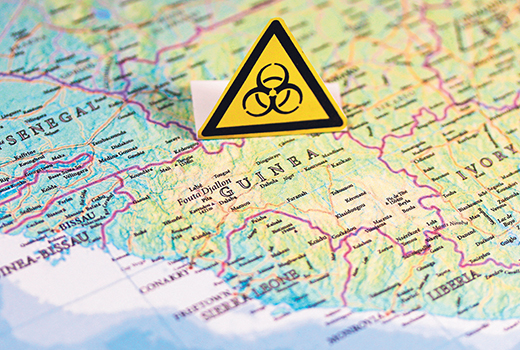What is Ebola virus disease? What is this scary disease that these days seems only an airline flight away? Ebola is a hemorrhagic fever virus. There are many such viral diseases, including yellow fever, Argentine hemorrhagic fever (the only examples for which reliable vaccines exist), Hantaan virus (found in the American Southwest), West Nile virus, dengue fever and many others.
The hemorrhagic fever viruses have similar modes of transmission that usually involve contact with some host animal (a fruit bat in the case of Ebola) or an intermediate “vector” like a mosquito or tick. Direct contact with infected or dead humans or animals, as in the case of Ebola, is a common way that the disease is caught and spread. In many instances, it’s due to contact with body fluids or excrement of rodents. In Africa, exposure to dead primates also seems to play a role in the spread of Ebola. (So far, it doesn’t seem that humans catch this disease by the airborne route.)
In general, the hemorrhagic fever viruses cause nonspecific symptoms at first, like (of course) fever, muscle aches and exhaustion. Later, they cause abnormalities in bleeding, so that blood vessels in the body are “leaky,” and clotting doesn’t work well — thus, the “hemorrhagic” part of the name. Patients bleed under their skin, internally or from the nose, mouth or eyes. Shock and death can develop in time.
Mortality varies in these diseases. In fact, Ebola outbreaks have had death rates as low as 25 percent to as high as the mid-90-percent range. It’s likely that we just don’t know enough about this disease or its subtypes to always know how it will “behave.” And it’s also likely that patients with the same diseases, treated in the U.S., would do better than in countries with limited healthcare. Even though the treatments available are limited and experimental, the supportive care available in modern hospitals may be life-saving. In addition, impoverished natives of affected countries often have poorer nutrition and general health, contributing to higher mortality.
As dangerous as these diseases are, their high lethality may limit their spread. (HIV doesn’t kill its victims for years, so it’s unfortunately very easy for it to spread far and wide.) So we must simply be vigilant. For those of us in healthcare, it means knowing the signs and symptoms and taking a detailed travel history from those with suspicious complaints. And it means using good precautions against blood and other body fluids. For those traveling to areas where Ebola is endemic, it means being aware of the risks and making informed decisions. And if you’re traveling where there is an outbreak, it also means being honest about symptoms and seeking out care before getting on an airplane and traveling home, potentially exposing others to an illness.
The wonderful thing, though, is this: Ebola is relevant to the readers of this publication, and to other Christian believers, who intentionally go into harm’s way to treat those who are afflicted with it. The world calls it madness, but we call it compassion. So the final thing we can do is this: Pray for the victims, pray for the caregivers, native and missionary, and pray for scientists to find a cure as soon as possible.
After all, God is far greater than even the most frightening virus!
The Centers for Disease Control has a nice summary of hemorrhagic fever viruses here: http://www.cdc.gov/ncidod/dvrd/spb/mnpages/dispages/vhf.htm. Here is a link to the CDC page on Ebola if you want more specific reading: http://www.cdc.gov/vhf/ebola/. If you’re interested, I’d also recommend the book, “The Hot Zone,” by Richard Preston. It concerns an all-too-real outbreak that occurred at a primate import company in Reston, Va., some years ago. (In fact, the virus involved is now called Ebola Reston!)

